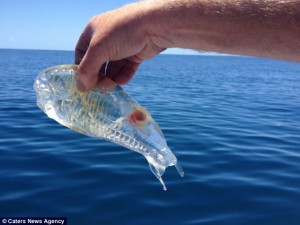“Translucent fish leaves New Zealand fisherman stunned” ~UK Metro
“Shrimp-like Translucent Sea Creature Found off Northland’s East Coast” ~Science World Report
“Now that’s a jelly fish! Stunned fisherman catches wobbly shrimp-like creature” ~Daily Mail
And another half-dozen variations on translucent, fish, shrimp, and baffled.
 This creature, whose image has gone viral in the last few days, is a salp. Salps are pelagic tunicates that drift through the open ocean, sometimes solitary, but often in large aggregations. It both swims and feed by pumping water through its body, filtering out plankton and expelling a jet of water from an organ called the excurrent siphon. In the water they look quite majestic.
This creature, whose image has gone viral in the last few days, is a salp. Salps are pelagic tunicates that drift through the open ocean, sometimes solitary, but often in large aggregations. It both swims and feed by pumping water through its body, filtering out plankton and expelling a jet of water from an organ called the excurrent siphon. In the water they look quite majestic.
Salps are among the most basal chordates, meaning they’re more closely related to us then they are to jellyfish or shrimp. Though understandable, mistaking a salp for a jellyfish has a Taxonomy Fail Index of 139.3, which is the highest I’ve seen in a mainstream publication.
While several news sources have at least provided a tentative identification of Salpa maxima, I disagree. I think it is far more likely that this is the solitary form of Thetys vagina, on of the largest salps in the Pacific Ocean. It has very prominent posterior projections (the narrow bit is actually the back on the animal). Though the images have no scale bars, it appears close to the 30-cm size common to this species. Most telling, however, is the number of muscle bands. In solitary form, Salpa maxima has fewer than 10 muscle bands, while Thetys vagina has more than 20, many of which are clearly visible in the photograph above.
thanks for clearing that up! 🙂
No bones: not a fish.
Actually, cartilaginous fishes like sharks, skates, and rays have no bones and are fish. So you can be a fish and not have bones.
In this case, however, the salp is clearly a salp.